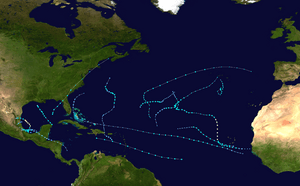2013 Atlantic hurricane season facts for kids
 |
|
| Season summary map | |
| First storm formed | June 5, 2013 |
|---|---|
| Last storm dissipated | November 22, 2013 |
| Strongest storm | Humberto – 980 mbar (hPa) (28.95 inHg), 90 mph (150 km/h) |
| Total depressions | 14 |
| Total storms | 13 |
| Hurricanes | 2 |
| Major hurricanes (Cat. 3+) | 0 |
| Total fatalities | 47 total |
| Total damage | $1.51 billion (2013 USD) |
| Atlantic hurricane seasons 2011, 2012, 2013, 2014, 2015 |
|
| Related article | |
|
|
The 2013 Atlantic hurricane season was a time when many tropical cyclones formed in the Atlantic Ocean. A tropical cyclone is a fast-spinning storm system. It brings strong winds and heavy rain.
This hurricane season officially started on June 1 and ended on November 30, 2013. The first storm, Tropical Storm Andrea, formed on June 5. The season was special because it was the first since 1994 without any very strong hurricanes. These are called "major hurricanes."
Contents
What is a Hurricane Season?
A hurricane season is the period each year when tropical storms are most likely to form. In the Atlantic Ocean, this usually runs from June 1 to November 30. During this time, the ocean waters are warm enough to create these powerful storms.
Scientists and weather experts watch the ocean closely. They track any developing storms. This helps them warn people who might be in the path of a hurricane.
Storms of 2013
Timeline generation failed: 2 errors found
Line 35: from:25/08/2013 till:26/08/2013 color C1 text:"Fernand (C1)"
- Invalid attribute 'C1' ignored.
Specify attributes as 'name:value' pair(s).
Line 35: from:25/08/2013 till:26/08/2013 color C1 text:"Fernand (C1)"
- Invalid attribute 'color' ignored.
Specify attributes as 'name:value' pairs.
The 2013 season had 13 named storms. Two of these became hurricanes. None of them grew into a "major hurricane." A major hurricane has winds of at least 111 miles per hour (178 km/h).
Tropical Storm Andrea
Tropical Storm Andrea was the first storm of the season. It formed on June 5 in the southern Gulf of Mexico. Andrea slowly grew stronger as it moved northeast. It made landfall in northeastern Florida on June 6. Landfall means the storm's center crossed over land. Andrea had winds up to 55 knots (63 mph or 102 km/h).
Tropical Storm Barry
Tropical Storm Barry started as a tropical depression on June 17. It formed in the Gulf of Honduras. A tropical depression is a weaker storm. It has winds less than 39 mph (63 km/h). Barry made landfall in Belize on the same day. It then moved across the Yucatán Peninsula. On June 19, Barry became a tropical storm.
Naming Hurricanes
Storms are given names to help people track them. The names are chosen from a list that repeats every six years. The names used in 2013 will be used again in the 2019 season. Some names are changed if a storm was very destructive.
Here are the names that were planned for 2013:
|
|
|
Retired Names
Sometimes, a storm name is "retired." This happens if a storm caused a lot of damage or deaths. The name is then removed from the list forever. This is done to show respect for the victims. It also prevents people from using a name that might bring back sad memories.
On April 12, 2014, the name Ingrid was retired. It was replaced by the name Imelda for the 2019 season.
More About Hurricanes
- List of Atlantic hurricane seasons
- 2013 Pacific hurricane season
- South-West Indian Ocean cyclone seasons: 2012–13, 2013–14
- Australian region cyclone seasons: 2012–13, 2013–14
- South Pacific cyclone seasons: 2012–13, 2013–14
See also
 In Spanish: Temporada de huracanes en el Atlántico de 2013 para niños
In Spanish: Temporada de huracanes en el Atlántico de 2013 para niños

